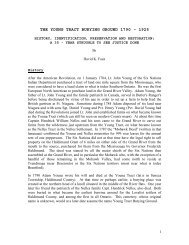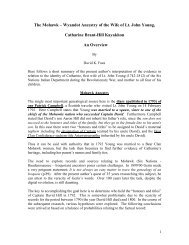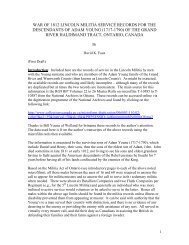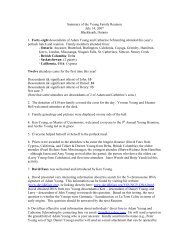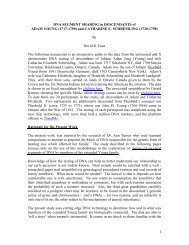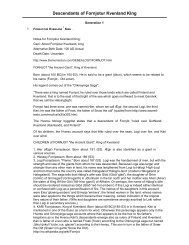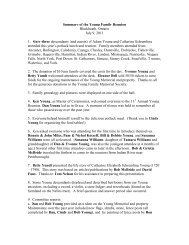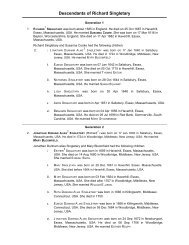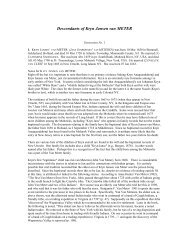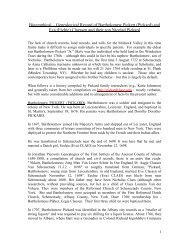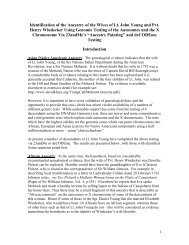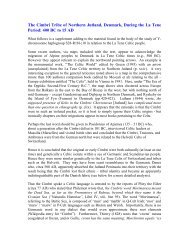Part 2 - Davidkfaux.org
Part 2 - Davidkfaux.org
Part 2 - Davidkfaux.org
Create successful ePaper yourself
Turn your PDF publications into a flip-book with our unique Google optimized e-Paper software.
Justinius attributed Caepio’s later misfortunes to the wrath of Appolo since the veneratedvaluables were once again disturbed (Cunliffe, 1997).The archaeological data supports the historical record in that there is a sudden influx ofDanubian artifacts (in other words a back migration) during the 3 rd Century BC in thewest as far as southern France – and north to the Belgae lands and Jutland. Hence it islikely that both the Tectosages of Toulouse, groups of Belgae, the Cimbri and otherunnamed tribes headed west shortly after 279 BC to establish themselves in otherlocations or those previously vacated. It is interesting to note that the respected authorHubert (1934) stated during the La Tene period, until about 300 BC, there was littleevidence of cultural equivalency in the artifact assemblage or burial customs betweenthose residing in Northern Jutland and Central Europe. However by this date what isseen in Jutland becomes more and more what one would find in the Alpine regions to thesouth.Actually, in the late La Tene period of 200 BC to 1 AD, a particularly Celticphenomenon, with a wall and ditch enclosure, has been found from the Atlantic coast ofFrance to Bohemia – the lands of the historical Central European Celts, but with thelargest number to date being found in southern Germany with 200 plus sites in Bavariaand Baden-Wurttemberg. These are the mysterious Viereckschanzen found outsidefortified settlements are now interpreted as ritual cultic sites, where possibly sacrificesand other activities were presided over by the “Celtic clergy”, the Druids (Maier, 2000).Again this phenomenon appears to reflect a cultural continuity that corresponds to thehistorically attested Celts with their epi-center in the region encompassing the headwatersof the Danube and Rhine Rivers.Konstam (2003) considers the La Tene “Celtic homeland” to have, originallyencompassed parts of the Czech Republic, Hungary, Austria, Switzerland, and southernGermany (p.20). Three foci noted by Cunliffe relating to the La Tene Celts are theMarne (eastern France), Moselle (western Germany), and Bohemian (Czech Republic).Haywood (2001) adds that at a later date the primary tribal areas corresponding to theseclusters are, respectively, the Parsii, Treveri, and Boii (see p.37). By the 4 th Century BCthere was strong cultural continuity between Celtic areas of France, Switzerland, Italy,Southern Germany, Austria and Bohemia. By the mid 3 rd Century there were twodivisions, the western (e.g., Switzerland) and eastern (eastern Alps to Transylvannia).It should be noted that as the centuries unfolded the apparent separation of CentralEurope into Celtic tribes in the south and German tribes in the north blurred to a degreeespecially in border areas and with the continued push of the Germanic tribes to thesouth. For example, late in the 1 st Century AD, just before the Romans established theLimes (defended border), and the provinces of Germania Superior and Inferior, theGermanic Batavi, and the Celtic Treveri under Julius Classicus and Julius Tutor with theCeltic Lingones led by Julius Sabinus, attempted to establish an independent Gallo-Germanic empire on both sides of the Rhine (Maier, 2000). Also we will see that theAllemanni, the prototypic German group of the 4 th Century AD, was likely an amalgamof Celt and German. A circa 400 AD medical compendium, De medicamentis, includes10



